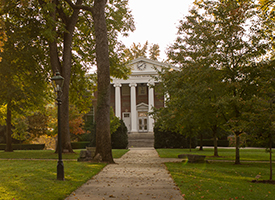
Focus on Philanthropy
Volunteers and Challenges Spur a Strong Year for Fundraising
Despite, or perhaps due to, a volatile economic crisis brought on by the pandemic, donations for the year pushed the Hollins Fund for 2019-20 over its $3.55 million goal, almost $400,000 more than the university raised the previous year. Overall philanthropic gifts for the year totaled more than $11.7 million, again up a substantial amount compared to the previous year.
Clark Hooper Baruch ’68, who chairs the development committee, credited the commitment of volunteers for much of the success. “The volunteers were pivotal in generating and building the kind of momentum needed for this level of effort. They made a real difference, and it wasn’t just the impressive overall number of volunteers, but also the breadth of experiences and classes represented in that group that helps us engage with people beyond those who are already in the donor pool.”
She especially emphasized the promising growth in younger alumnae/i volunteering. “They’re the key to securing a healthy future for Hollins the farther we travel into this century.”
What is also clear in the rearview: Hollins alumnae/i and friends are generous in good times and bad, and they love a good challenge.
Last December, an anonymous donor offered to match every gift made in the month up to $100,000, and the challenge was met barely halfway into the month. The effort so impressed the donor that she promised to match any additional gift, up to $5,000, for the remainder of the calendar year.
Then, in June, another anonymous donor offered up $100,000 if Hollins could generate 500 donors in the month. The donor reiterated her conviction that Hollins is in a very strong place, but that “now is the time for anyone who cares about Hollins to give something, no matter what the size. There is no better time than now to show your support of Hollins.”
Once again, the challenge was not only met, but swiftly, as the goal was met on June 21. Yet another donor offered an extra $25,000 if Hollins could generate another 100 gifts in the final nine days of the fiscal year… and our donors responded with more than 350 additional gifts!
“This spring and summer have been such a roller coaster of emotions for us,” said Suzy Mink, vice president for external relations. “We have all been heartsick for the way the pandemic disrupted the campus experience for our students, faculty, and staff, and especially our graduating seniors. Further, we knew Hollins would face some unexpected financial strain from having to close the campus, and our office felt a tremendous responsibility to do what we could to minimize that strain.
“We were already impressed in the spring with how many of our alumnae/i reached out to us, or responded to our calls, with such incredible generosity, but then June kicked all of that to another level.”
![]()
The Costly Road to Reopening
In the world of “yes and” news, yes, the successes of the FY20 fundraising efforts are cause for great celebration, and the added financial challenges of responsibly operating a complex small university during an ongoing pandemic are expected to continue piling up in the summer and fall months.
As of early July, the projected additional costs for unexpected operational needs around reopening the campus were at $600,000 and expected to increase as the term progresses. The added costs run from the expensive and complicated—additional lab or photography equipment to minimize the need for sharing of items, for example—to the simple… yet still expensive. An example of the latter is the projected costs for all the disinfecting wipes and hand sanitizing gels needed to meet the needs of keeping classrooms, common spaces, and equipment and appliances clean before and after use: $30,000. “That amount does not include all of the cleaning and disinfecting supplies that the facilities staff would be using daily,” said Executive Vice President and Chief Operating Officer Kerry Edmonds, who said adding in those costs would more than triple the amount.
Edmonds said the ultimate challenge has been and remains preparing fiscally for the unknown.
“Hollins is in a more secure position, financially and otherwise, than most small private colleges, but we can be almost certain this fall will come with added costs, and potential revenue losses, that we can’t reasonably project with the shifting landscape of this pandemic. Nevertheless, we are committed to doing what we can to make the fall term a positive and rewarding one for our students, while respecting the public health guidelines and health concerns for our entire community.”
![]()
Student Village Update
When this issue went to press, the first three houses of Phase II of the Student Apartment Village were on course to be open and available for students by the start of fall term. The three new homes add 14 rooms and a total of 28 beds to the housing capacity. An additional three houses are planned—funding is still being secured—which will bring the entire capacity for the area to as many as 98 beds.
One key factor in the effort was the securing of a $400,000 challenge from the Cabell Foundation in May 2019. Thanks to donors helping Hollins raise $1.2 million over a single year in support of the project, the grant was provided in June.
“It’s been so great to be able to gather and welcome people, whether it’s in our kitchen, or in the common space, or on our front porch in a rocking chair. Whether it’s studying or hanging out, it’s been a great place to just be together,” said Monica Osborne ’20 as she reflected on being one of the village’s inaugural residents.
The Student Village could be especially valuable in the fall, as their outdoor gathering areas work well for socially distanced gatherings, and their kitchen and living room areas will allow for several students to gather while maintaining the minimum distance expectations and wearing face masks.
Student Village Progress
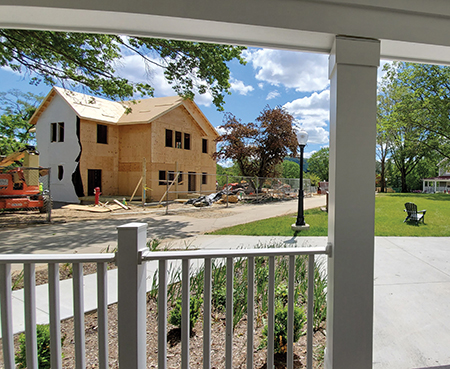
May 12, 2020
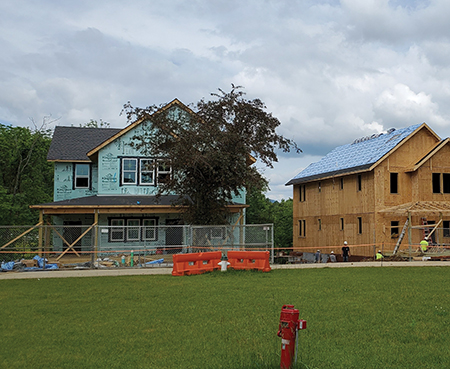
May 26, 2020
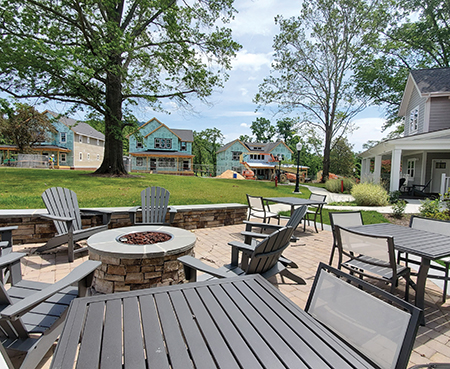
June 22, 2020
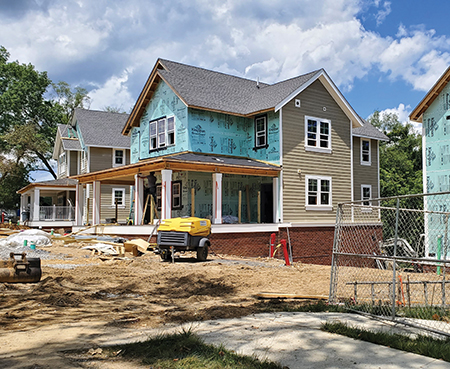
July 15, 2020
